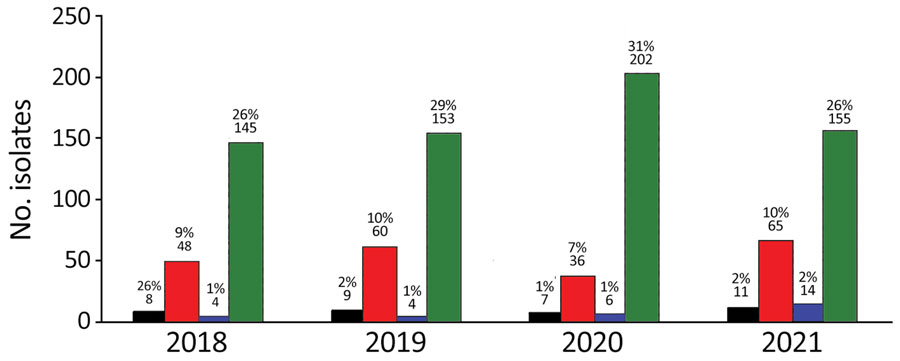Volume 29, Number 6—June 2023
Online Report
One Health Approach for Reporting Veterinary Carbapenem-Resistant Enterobacterales and Other Bacteria of Public Health Concern
Figure 2

Figure 2. Numbers of MRSA and methicillin-resistant Staphylococcus pseudintermedius isolates from canids in study of One Health approach for reporting veterinary carbapenem-resistant Enterobacterales and other bacteria of public health concern, United States, January 1, 2018–December 31, 2021. Numbers and percentages of antimicrobial-resistant isolates (compared with all canine Staphylococcus spp. isolates) per year for each laboratory are shown. Kansas State Veterinary Diagnostic Laboratory isolates are indicated by black bars (MRSA) and red bars (methicillin-resistant S. pseudintermedius); University of Missouri Veterinary Medical Diagnostic Laboratory isolates are indicated by blue bars (MRSA) and green bars (methicillin-resistant S. pseudintermedius). Total numbers of Staphylococcus spp. from canids at Kansas State Veterinary Diagnostic Laboratory were 536 in 2018, 578 in 2019, 530 in 2020, and 680 in 2021. Total numbers of Staphylococcus spp. isolates from canids at University of Missouri Veterinary Medical Diagnostic Laboratory were 563 in 2018, 532 in 2019, 661 in 2020, and 608 in 2021.
1Current affiliation: National Bio and Agro-Defense Facility, Manhattan, Kansas, USA.
2Current affiliation: Kansas Department of Agriculture, Manhattan, Kansas, USA.
3Current affiliation: Kansas Intelligence Fusion Center, Topeka, Kansas, USA.